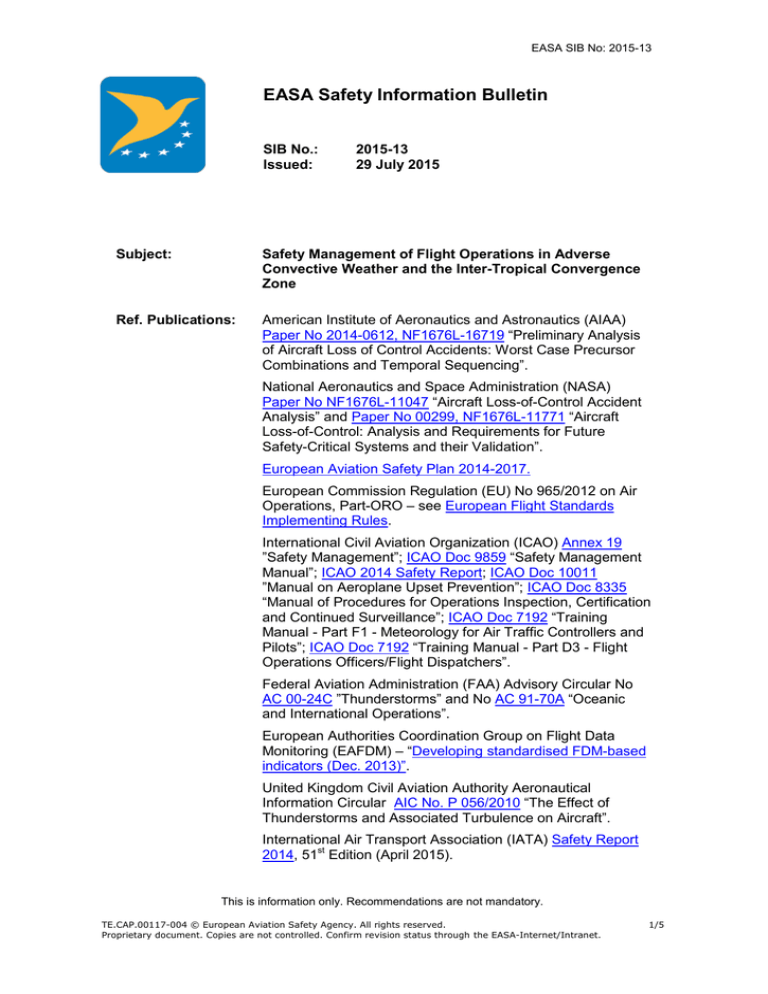
EASA SIB No: 2015-13
EASA Safety Information Bulletin
SIB No.:
Issued:
2015-13
29 July 2015
Subject:
Safety Management of Flight Operations in Adverse
Convective Weather and the Inter-Tropical Convergence
Zone
Ref. Publications:
American Institute of Aeronautics and Astronautics (AIAA)
Paper No 2014-0612, NF1676L-16719 “Preliminary Analysis
of Aircraft Loss of Control Accidents: Worst Case Precursor
Combinations and Temporal Sequencing”.
National Aeronautics and Space Administration (NASA)
Paper No NF1676L-11047 “Aircraft Loss-of-Control Accident
Analysis” and Paper No 00299, NF1676L-11771 “Aircraft
Loss-of-Control: Analysis and Requirements for Future
Safety-Critical Systems and their Validation”.
European Aviation Safety Plan 2014-2017.
European Commission Regulation (EU) No 965/2012 on Air
Operations, Part-ORO – see European Flight Standards
Implementing Rules.
International Civil Aviation Organization (ICAO) Annex 19
”Safety Management”; ICAO Doc 9859 “Safety Management
Manual”; ICAO 2014 Safety Report; ICAO Doc 10011
”Manual on Aeroplane Upset Prevention”; ICAO Doc 8335
“Manual of Procedures for Operations Inspection, Certification
and Continued Surveillance”; ICAO Doc 7192 “Training
Manual - Part F1 - Meteorology for Air Traffic Controllers and
Pilots”; ICAO Doc 7192 “Training Manual - Part D3 - Flight
Operations Officers/Flight Dispatchers”.
Federal Aviation Administration (FAA) Advisory Circular No
AC 00-24C ”Thunderstorms” and No AC 91-70A “Oceanic
and International Operations”.
European Authorities Coordination Group on Flight Data
Monitoring (EAFDM) – “Developing standardised FDM-based
indicators (Dec. 2013)”.
United Kingdom Civil Aviation Authority Aeronautical
Information Circular AIC No. P 056/2010 “The Effect of
Thunderstorms and Associated Turbulence on Aircraft”.
International Air Transport Association (IATA) Safety Report
2014, 51st Edition (April 2015).
This is information only. Recommendations are not mandatory.
TE.CAP.00117-004 © European Aviation Safety Agency. All rights reserved.
Proprietary document. Copies are not controlled. Confirm revision status through the EASA-Internet/Intranet.
1/5
EASA SIB No: 2015-13
Applicability:
National Aviation Authorities (NAAs), Commercial Air
Transport (CAT) operators of multi-pilot operations.
Background:
Loss of control in flight (LOC-I) is a predominant cause of
aviation accidents1,2,3. Many initiatives have been taken to
address this major aviation safety risk from the pilot training
perspective4.
Analyses of recent aircraft accidents reveal that LOC-I results
from a wide spectrum of contributing factors, often occurring
in combination5,6, of which inclement weather is part. This
requires the implementation of a comprehensive set of LOC-I
prevention schemes addressing all potential LOC-I causes,
based on accident and incident data as well as known and
emerging risks.
In this respect, it is of particular strategic importance to
ensure that proactive accident prevention is achieved through
adequate and efficient safety management of flight operations
in adverse convective weather and large-scale areas of
concentrated inclement weather such as the Inter-Tropical
Convergence Zone, or ITCZ (including various hazards such
as thunderstorms, turbulence, ice crystals, icing, hail,
windshear, lightning, etc.).
Description:
The ITCZ is characterised by powerful convective activity
which generates often vigorous thunderstorms over large
areas.
The position of the ITCZ varies with the seasons. In July and
August, over the Atlantic and Pacific, the ITCZ is between 5
and 15 degrees north of the Equator, but over the land
masses of Africa and Asia it is located further north. In
eastern Asia, the ITCZ may propagate up to 30 degrees north
of the Equator. In January, over the Atlantic, the ITCZ is
generally located no further south than the Equator, but it
extends much further south over the land masses of South
America, Southern Africa, and Australia.
Where the trade winds are weak, the ITCZ is characterised by
isolated Cumulus (Cu) and Cumulonimbus (Cb) cells.
However, where the trade winds are stronger, the ITCZ can
generate a solid line of active Cb cells embedded with other
cloud types, developing as a result of instability at higher
levels. Cb tops can reach and sometimes exceed an altitude
of 55 000 feet, and the ITCZ can be as wide as 300 nautical
1
2
3
4
5
6
Annual Safety Review 2013, Executive Summary, page 6
European Aviation Safety Plan 2014-2017, Pages 8, 9, 22, 24 and 26
ICAO 2014 Safety Report, Appendix 1
See in particular ICAO Doc 10011 ”Manual on Aeroplane Upset Prevention”
AIAA Paper No 2014-0612, NF1676L-16719
NASA Paper No 00299, NF1676L-11771 “Aircraft Loss-of-Control: Analysis and Requirements for Future SafetyCritical Systems and their Validation”
This is information only. Recommendations are not mandatory.
TE.CAP.00117-004 © European Aviation Safety Agency. All rights reserved.
Proprietary document. Copies are not controlled. Confirm revision status through the EASA-Internet/Intranet.
2/5
EASA SIB No: 2015-13
miles in places, thus presenting a formidable obstacle to
aircraft transit.
Aircraft flying through an “active” ITCZ (strong trade winds)
will most probably encounter the hazards associated with
thunderstorms and adverse convective weather. All
thunderstorms have conditions that are a hazard to aviation.
These hazards occur separately or in various combinations.
While not every thunderstorm contains all hazards, it is not
possible to visually determine which hazards a thunderstorm
contains.
Inclement weather and atmospheric disturbances are
potential contributory factors to loss of control in flight
(LOC-I). Hence the need for effective safety management
adapted to the specific risks related to flight operations in the
ITCZ.
In this regard, it is reminded that strategic (planning) and
tactical (in-flight) weather avoidance is best practice.
Risk mitigation should be achieved through the operator’s
Safety Management System (SMS) based on hazard
identification and data monitoring.
Recommendation(s): When operating in adverse convective weather and the ITCZ
area, operators should thoroughly determine their exposure to
ITCZ risks and ensure that efficient mitigating actions are
continually and consistently taken, based on data-driven
strategies, thereby actively preventing accidents resulting
from LOC-I.
Safety management principles should apply to all aspects of
flight operations in adverse convective weather and the ITCZ
with a view to implementing risk mitigation strategies and
proactively taking preventive actions. Particular attention
should be paid to precursors of LOC-I.
In addressing the specific risks related to adverse convective
weather and operations in the ITCZ, it is therefore
recommended that, as a minimum, the following aspects
and/or contributing factors are considered:
Operators
Safety risk management7:
- Predictive, proactive and reactive identification
processes for ITCZ-related hazards;
- Safety data collection which is consistent with aircraft
operations in adverse convective weather;
7
In the sense of APPENDIX 2 (SMS Component 2) of ICAO Annex 19 and chapter 5 of ICAO Doc 9859 “Safety
Management Manual”.
This is information only. Recommendations are not mandatory.
TE.CAP.00117-004 © European Aviation Safety Agency. All rights reserved.
Proprietary document. Copies are not controlled. Confirm revision status through the EASA-Internet/Intranet.
3/5
EASA SIB No: 2015-13
- FDM-based indicators8 targeting the risks related to
adverse convective weather and ITCZ (for example:
number of events associated with excessive roll, stall
protection trigger, excessive speed / vertical speed /
accelerations and/or insufficient energy at high altitude);
- Safety data analysis to adequately identify existing or
emerging risks associated with aircraft operations in the
ITCZ;
- Trend analysis to properly identify in a timely manner
existing or emerging (isolated or combined) contributing
factors to LOC-I, such as, but not limited to:
» Increased rate of turbulence / icing encounter for the
flights in the vicinity of the ITCZ compared to flights
in other geographical areas of operation;
» Poor strategic or operational decision making related
to weather avoidance;
» Inaccurate or outdated meteorological data,
products, reports or forecasts used for flight planning
or in flight;
» Scarce adherence to Standard Operating
Procedures;
» Erosion of skills, risk-taking attitudes or lack of
awareness of the potential of LOC-I in adverse
convective weather and the ITCZ.
- Defensive strategy and risk mitigation appropriately
addressing each identified contributing factors to LOC-I.
Flight planning and dispatch:
- Adequacy of flight preparation and dispatch with
particular regard to anticipated weather conditions;
- Fuel policy and guidance that is consistent with
anticipated operational constraints and weather
contingency planning, providing an appropriate range of
possible strategic avoidance routes and the ability to
conduct unplanned in-flight deviations from intended
route;
- Dispatch with Minimum Equipment List / Configuration
Deviation List that preserves the ability of the aircrew to
avoid weather and to mitigate the effects of inadvertent
inclement weather encounter, such as requiring
appropriate reliability of weather radar, de-icing / antiicing systems, navigation systems, air data.
8
European Authorities Coordination Group on Flight Data Monitoring: EAFDM – Developing standardised FDMbased indicators (Dec. 2013).
This is information only. Recommendations are not mandatory.
TE.CAP.00117-004 © European Aviation Safety Agency. All rights reserved.
Proprietary document. Copies are not controlled. Confirm revision status through the EASA-Internet/Intranet.
4/5
EASA SIB No: 2015-13
In-flight procedures:
- Avoidance manoeuvres should be performed as early
as possible, as weather radar information on nearby
cells becomes partial, and possibly misleading, when
the aeroplane gets closer to convective areas;
- No attempts to climb over the convective area should
be undertaken when buffet and performance margins
are dangerously reduced.
Competency of personnel:
- Effective detection and resolution of lack of knowledge,
deficient skills and inappropriate attitudes of pilots,
dispatchers, maintenance personnel and safety officers
as regards their proficiency to ensure safe flight
operations in adverse convective weather and the ITCZ;
- Adequate initial, recurrent, route-specific or seasonal
refresher training with regard to the specific
geographical areas of operation associated with the
ITCZ.
National Aviation Authorities
When approving an “area of operation” or overseeing existing
operations in the ITCZ, competent authorities should:
Evaluate the operators’ risk assessment to ensure that it is
appropriate for the operations conducted, considering as a
minimum the above mentioned aspects;
Assess the adequacy and the correct implementation of
the resulting mitigating measures.
Contact(s):
For further information contact the Safety Information Section,
Certification Directorate, EASA. E-mail: ADs@easa.europa.eu.
This is information only. Recommendations are not mandatory.
TE.CAP.00117-004 © European Aviation Safety Agency. All rights reserved.
Proprietary document. Copies are not controlled. Confirm revision status through the EASA-Internet/Intranet.
5/5



